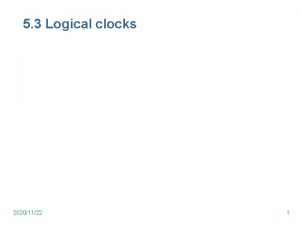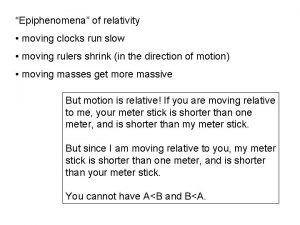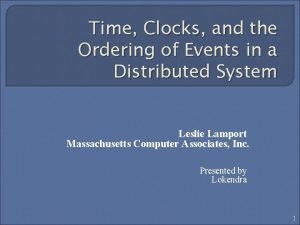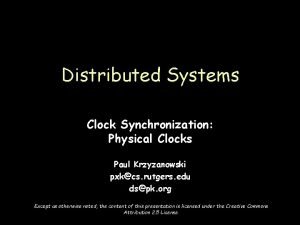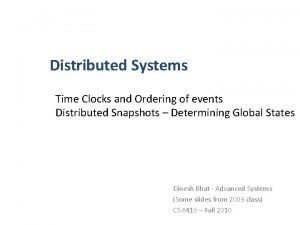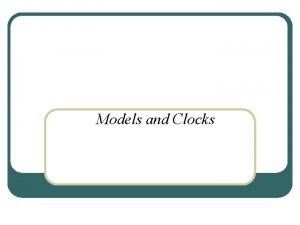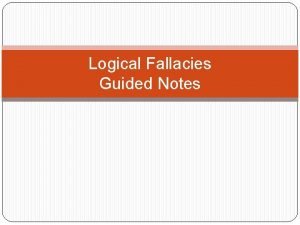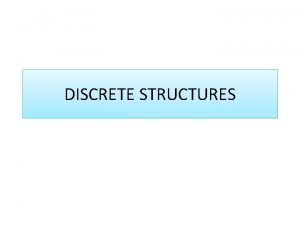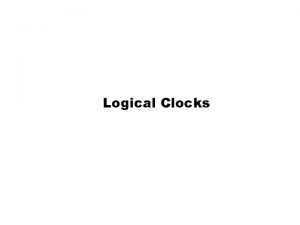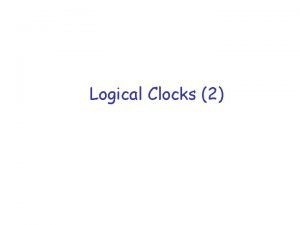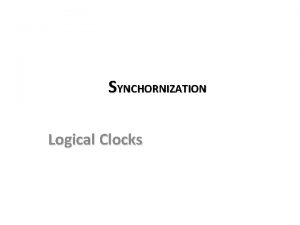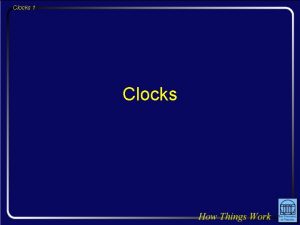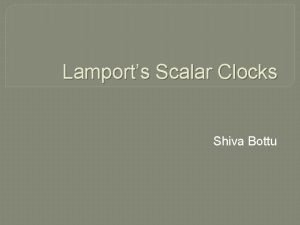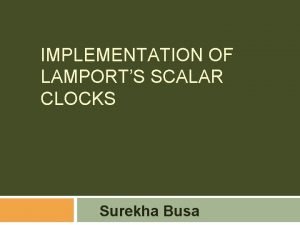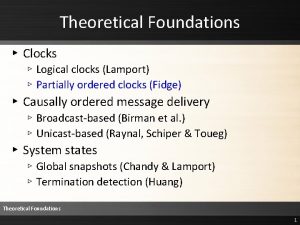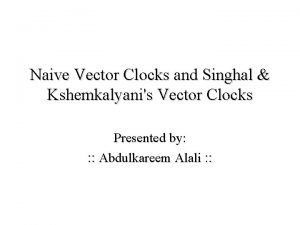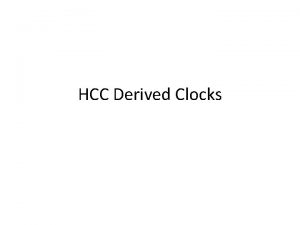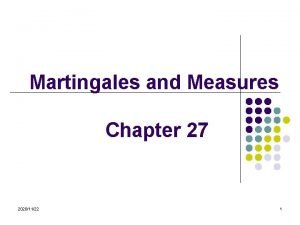5 3 Logical clocks 20201122 1 Lamports logical
















![Vector logical clock at Pi n n Pi initializes its vector clock Vi[ ] Vector logical clock at Pi n n Pi initializes its vector clock Vi[ ]](https://slidetodoc.com/presentation_image_h/8324269eea2939618eeb47e061c20f51/image-17.jpg)





- Slides: 22

5. 3 Logical clocks 2020/11/22 1

Lamport’s logical clock Time P Q R 2020/11/22 p 1 1 1 q 1 1 r 1 p 2 2 q 2 2 2 r 2 p 3 p 4 45 3 q 3 3 q 4 4 3 r 3 4 q 5 5 r 4 2

Clock Ci maintained by process Pi 2020/11/22 3

“Happened-before” relation (review) n a b defined by: If a occurs earlier than b in same process, then a b. u If a is sending event and b is receiving event of same message, then a b. u If a b and b c, then a c. [Transitive] u n n If a b, then a happened before b a and b are concurrent if neither a b nor b a. 2020/11/22 4

Clock condition: 2020/11/22 If a b then C(a) < C(b) 5

Comments 2020/11/22 6

Causality Violation Suppose M 1’s sending event happened before M 3’s sending event. n Causality violation occurs if M 1 is delivered after M 3 (In particular, non-FIFO delivery is causality violation). n Migrate foo to P 2 P 1 P 2 “ P 3 foo e v a h u o Do y “Given to P 2 M 1 Time 2020/11/22 ? ” (=M 2)” M 3)” = ( ? o ave fo h u o y o “D “Nope” 7

Ordering options 2020/11/22 8

Total ordering vs. causal ordering Totally ordered deliveries. Causally ordered deliveries. 2020/11/22 9

Delivery mechanism 2020/11/22 10

Hold-back Q and delivery Q Communication subsystem messages 2020/11/22 11

How can we prevent causality violation? Q 1 Q 2. Qn Head 2020/11/22 12

Problems Vector clock condition: 2020/11/22 a b iff V(a) < V(b) 13

Event counter P 1 P 2 P 3 1 1 2 Event counter at Pi : Initialized at 0 and incremented for each event 1 2 2 3 3 4 2020/11/22 14

Vector clock P 1 P 2 P 3 V 2 at t 2 = ( t 1, t 2, t 3 ) t 1, t 2, t 3 are latest event counts at P 1, P 2 , P 3 that are reachable backwards from there (0 if non-reachable): (2, 4, 2) in the example 2020/11/22 t 1 t 3 t 2 15

Updating vector clock P 1 P 3 0 V 2 at t 2 = [ t 1, t 2, t 3 ] V 3 at s 3 = [s 1, 0 , s 3 ] max P 2 s 1 t 3 max s 3 V 2 at r 2 = ( t 1, t 2+1, s 3 ) Local event count M is timestamped by V 3 2020/11/22 t 2 M r 2 16
![Vector logical clock at Pi n n Pi initializes its vector clock Vi Vector logical clock at Pi n n Pi initializes its vector clock Vi[ ]](https://slidetodoc.com/presentation_image_h/8324269eea2939618eeb47e061c20f51/image-17.jpg)
Vector logical clock at Pi n n Pi initializes its vector clock Vi[ ] = [0, …, 0]. For each event of Pi (self-component) u n n Vi[i]++ When sending msg, Pi attaches vector Vi[ ] as timestamp (after incrementing) Upon receiving msg with timestamp, ts=Vj[ ], Pi updates Vi[ ] by Vi[i]++ u V [k] = Max { V [k], V [k] } for all k != i. i i j u 2020/11/22 17

Example a P 1 P 2 000 100 010 P 3 000 001 200 220 300 230 240 250 450 243 260 550 2020/11/22 242 264 273 18

Example c P 1 P 2 000 100 For fixed event e. x e iff V(x) < V(e) 000 x 010 001 200 220 300 230 240 250 450 550 242 243 260 2020/11/22 P 3 264 273 e 19

Example b P 1 P 2 000 100 For fixed event e. 200 e x iff V(a) < V(x) 300 010 450 242 243 260 x 2020/11/22 000 001 220 230 e 240 250 550 P 3 264 273 20

Notation n n We define global V(e) = Vi(e) if event e happens in Pi We write V(a) V(b) if u V(a)[k] V(b)[k] for all k. u n Here V(a)[k] denotes the kth component of V(a). We write V(a) < V(b) if u V(a)[k] V(b)[k] for all k, and u 2020/11/22 V(a)[j] < V(b)[j] for at least one j 21

a b iff V(a) < V(b) P 1 P 2 P 3 Proof: For a fixed b, a b iff a is in shaded area iff each component of V(a) corresponding component of V(b). a t 3 t 1 For formal proof see lecture notes. b 2020/11/22 t 2 22
 Lamport's logical clocks
Lamport's logical clocks Moving clocks run slow
Moving clocks run slow Time clocks and the ordering of events
Time clocks and the ordering of events Berkeley algorithm example
Berkeley algorithm example Water clocks han dynasty
Water clocks han dynasty Clues clocks and keys
Clues clocks and keys Leslie lamport time clocks
Leslie lamport time clocks Graham and green clocks
Graham and green clocks Interleaving model in distributed computing
Interleaving model in distributed computing Dave west clocks
Dave west clocks Appointment clocks
Appointment clocks Physical clock
Physical clock Time clocks and the ordering of events
Time clocks and the ordering of events Fantasy surrealism
Fantasy surrealism Equivalence statement definition
Equivalence statement definition Logical equivalence
Logical equivalence Accident fallacy
Accident fallacy Google search logical operators
Google search logical operators Logical structure example
Logical structure example Rhetorical devices and logical fallacies
Rhetorical devices and logical fallacies Celebrities with linguistic intelligence
Celebrities with linguistic intelligence Logical fallacies guided notes
Logical fallacies guided notes Array indices must be positive integers or logical values
Array indices must be positive integers or logical values
